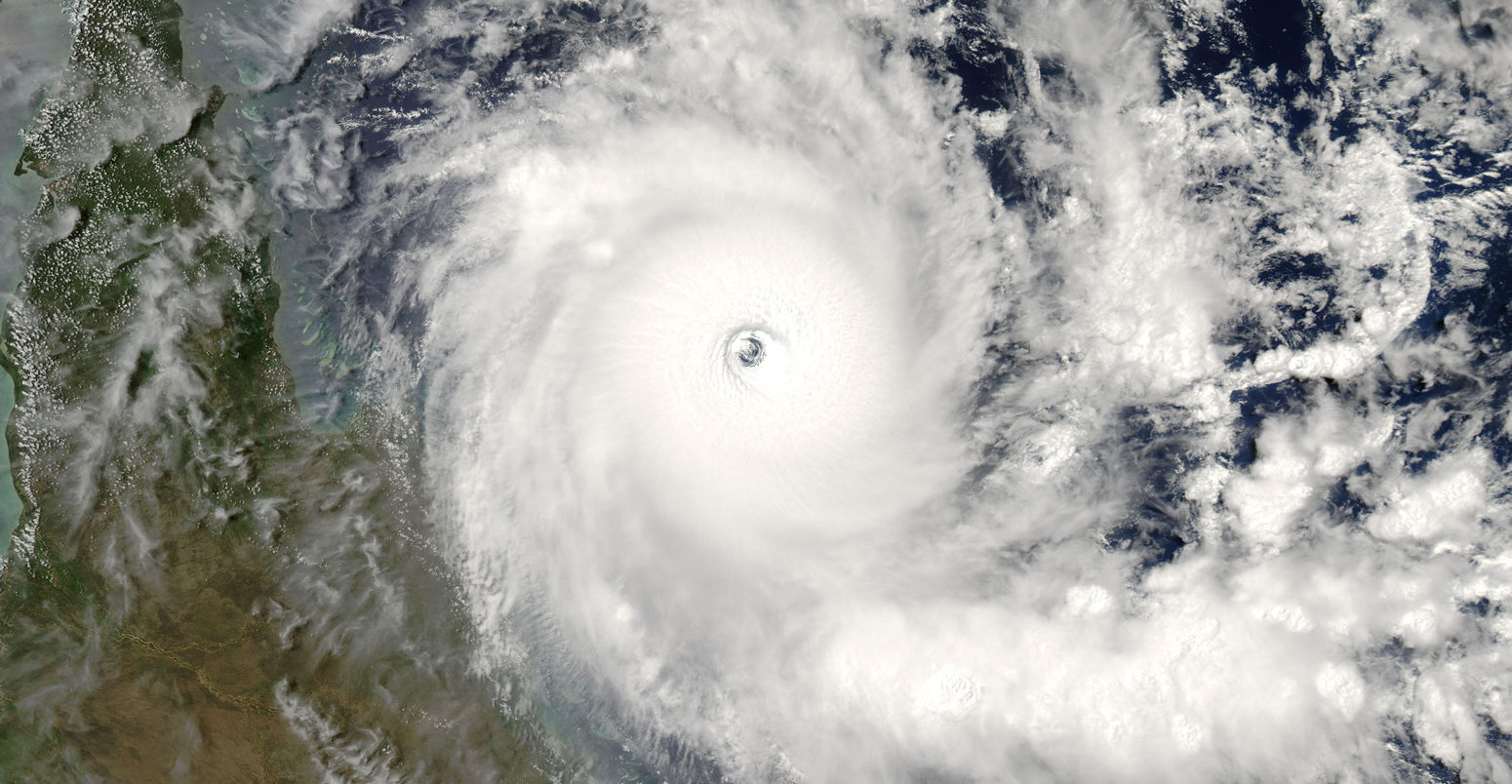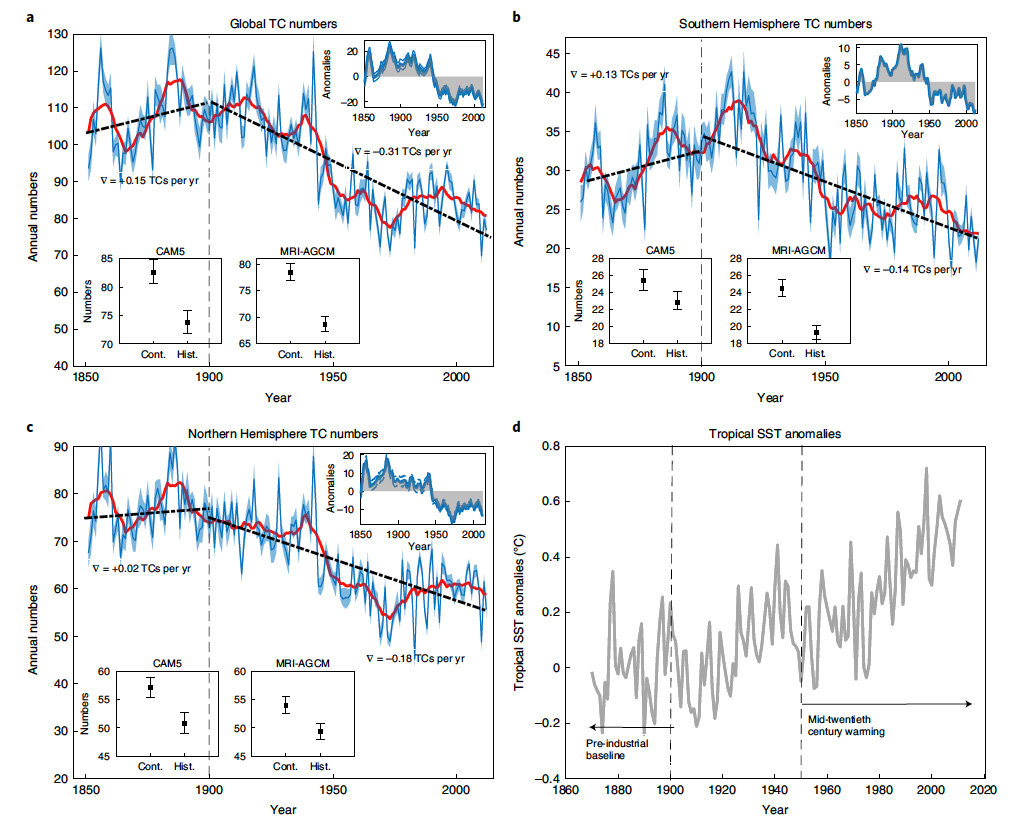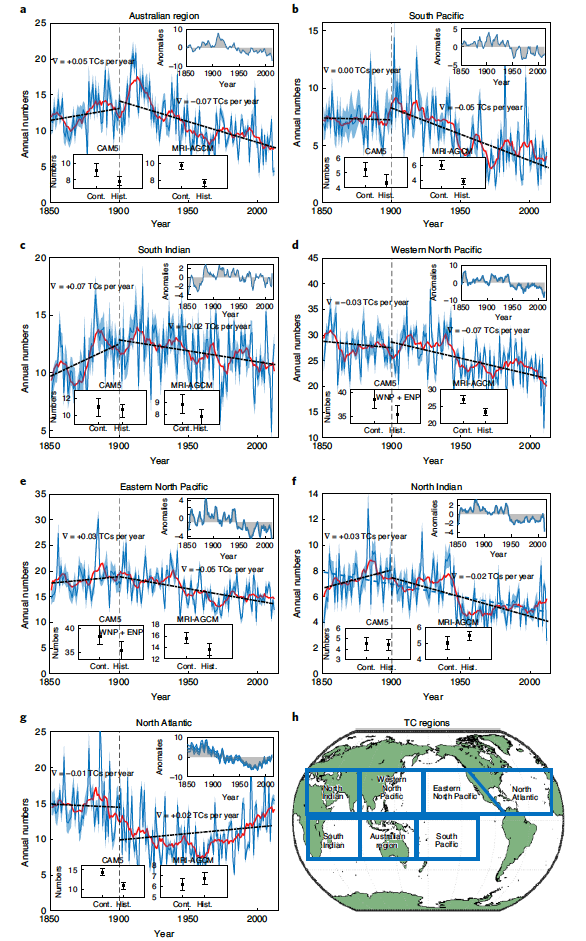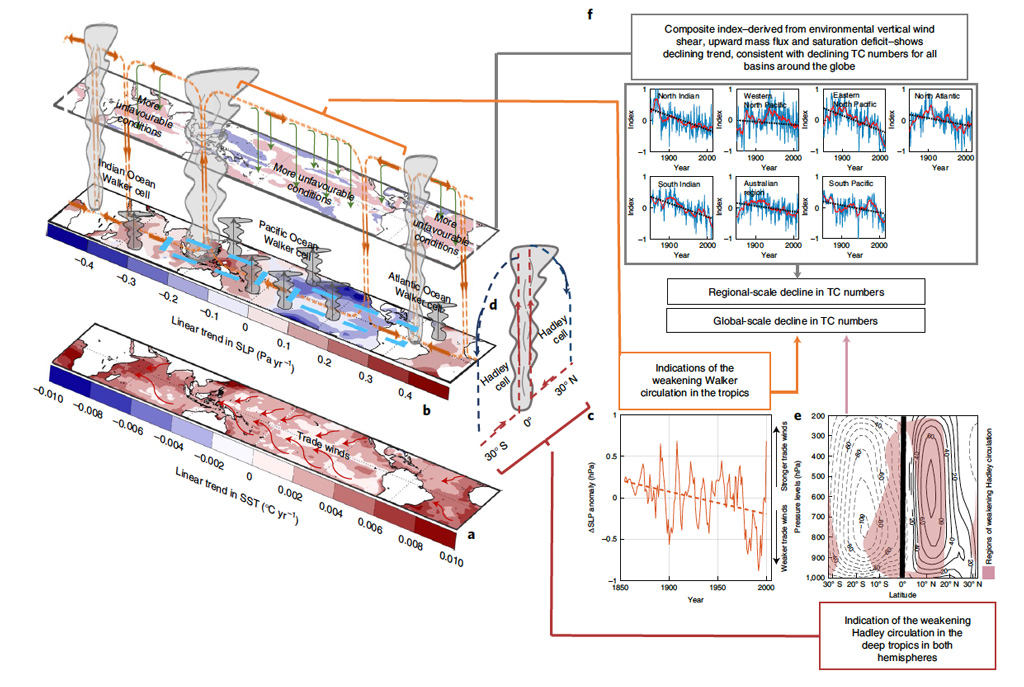
Tropical cyclones now ‘13% less frequent’ due to climate change
Ayesha Tandon
06.27.22Ayesha Tandon
27.06.2022 | 4:43pmClimate change has driven a 13% decline in the frequency of tropical cyclones since pre-industrial times, new research finds.
Tropical cyclones are complex phenomena, which only form under specific atmospheric and oceanic conditions. Research suggests that, as the climate warms, changing conditions are making tropical cyclones less frequent. However, a lack of long-term cyclone data makes this trend difficult to quantify.
The paper, published in Nature Climate Change, aims to fill this gap using “reanalysis” data that combines observations and model simulations. The findings show a 13% decrease in tropical cyclones around the world between 1850-1900 and 1900-2000. More specifically, they find a drop from more than 100 tropical cyclones a year in pre-industrial times to around 80 in 2012. The study does not look at changes in the intensity – or damage – of cyclones over this period.
Warming is causing two major global atmospheric circulations – the Walker and Hadley circulations – to weaken, with knock-on effects that create “more hostile conditions” for cyclones to form, the authors suggest.
While cyclone frequency has declined over 1900-2012 in six of the seven regions the study investigates, the researchers find a slight increase in the North Atlantic, driven by a rising trend over recent decades. They suggest that this is due to a combination of natural variability and a decrease in local air pollution.
This is a ”very interesting and important paper”, a scientist not involved in the study tells Carbon Brief. He adds that it is “the first paper to demonstrate that anthropogenic global warming has already produced a significant drop in the numbers of tropical systems both globally and the Atlantic between pre-industrial conditions and during the 20th century”.
The decrease in tropical cyclone frequency is “good news”, the lead author of the study tells Carbon Brief. However, he adds that it is not the whole story – emphasising that through changes in cyclone intensity and location, climate change has already put many people at greater risk from tropical cyclones.
Declining frequency
Tropical cyclones are among the most dangerous natural hazards on earth. The rapidly rotating storms form over warm tropical waters, and can bring sustained wind speeds of more than 100 miles per hour. Communities near coasts are particularly vulnerable to the impacts of tropical cyclones, such as storm surges and intense rainfall that can lead to severe flooding.
Since the 1970s, tropical cyclones have been detected using satellite data. However, before the widespread use of satellites, the observed record of tropical cyclones was patchy and the limited availability of high-quality observational data makes it tricky to find long-term trends in cyclone frequency.
The new study tackles this problem by using “reanalysis” data – a combination of model and observational data that, according to the European Centre for Medium-Range Weather Forecasts (ECMWF), provides “the most complete picture currently possible of past weather and climate”.
The authors use the 20th century reanalysis dataset, produced by the National Oceanic and Atmospheric Administration, to create a long-term proxy record of tropical cyclone activity over 1850-2012. Dr Savin Chand – a researcher at Federation University in Australia and lead author of the study – tells Carbon Brief that this “state of the art” reanalysis dataset is an “innovative product” that provides “the bridge between observations and model to generate more consistent datasets”.
Between a “pre-industrial” baseline period of 1850-1900 and 1900-2000, the researchers find that annual tropical cyclones frequency decreased by 13% overall. More specifically, they find a drop from more than 100 a year in pre-industrial times to around 80 in 2012. A “much larger” decline of 23% was seen after 1950, when sea surface temperatures were warming more quickly, they add.
The authors also investigate the difference between tropical cyclone occurrence in northern and southern hemispheres. They find that the most tropical cyclones occur in the northern hemisphere, but that the decline in tropical cyclones frequency was more significant here. Between the pre-industrial period and 2012, the number of tropical cyclones recorded in the northern hemisphere per year dropped from approximately 75 to 60.
The figure below shows annual tropical cyclone frequency over 1850-2012, globally (top left), in the southern hemisphere (top right) and in the northern hemisphere (bottom left). Blue lines show the annual tropical cyclone frequency, red lines show the five-year running average and black lines show the 1850-1900 and 1900-2012 trends. The bottom-right figure shows tropical sea surface temperature rise, compared to the pre-industrial baseline.

“This is an excellent study,” Dr Masato Sugi – a researcher at Japan’s Meteorological Research Institute, who was not involved in the study – tells Carbon Brief.
It is a ”very interesting and important paper”, adds Dr Christopher Landsea – the science and operations officer at the National Oceanic and Atmospheric Administration’s National Hurricane Centre, who was not involved in the study. He tells Carbon Brief:
“This is the first paper to demonstrate that anthropogenic global warming has already produced a significant drop in the numbers of tropical systems both globally and in the Atlantic between pre-industrial conditions and during the 20th century.”
The decrease in tropical cyclone frequency “is good news”, Chand tells Carbon Brief. However, he adds that it is not the whole story – emphasising that through changes in cyclone intensity and location, climate change has already put many people at greater risk from tropical cyclones.
Natural variability
Tropical cyclones are complex phenomena that only form under specific atmospheric and oceanic conditions. These include high sea surface temperatures and low vertical wind shear – a measure of how much winds vary in direction or strength with height.
Small fluctuations in ocean and atmospheric conditions can significantly affect how easy it is for a tropical cyclone to form. As a result, natural variability – variations in atmospheric and oceanic patterns that are not caused by humans – plays an important role in tropical cyclone counts in any individual year.
For example, cyclone activity in the Pacific Ocean typically increases during El Niño years, while fewer cyclones are seen in the Atlantic.
Chand tells Carbon Brief that in past research on tropical cyclone frequency, there have been “different trends noted in different studies” due to the high natural variability. This paper is novel, he says, because “now we have got a long-term data set to properly remove the effects of natural variability and other external factors that may be affecting the trend”.
As well as exploring global trends, the authors investigated changes in tropical cyclone frequency in different regions of the world. Of the seven regions studied, six showed a trend of decreasing tropical cyclone numbers from 1900 to 2012.
The figure below shows annual tropical cyclone frequency over 1850-2012 for seven different regions of the world. Blue lines show the annual tropical cyclone frequency, red lines show the five-year running average and black lines show the 1850-1900 and 1900-2012 trends. The bottom-right figure shows the seven regions.

The North Atlantic is the one region to show an increase in tropical cyclone frequency in recent decades, bucking a declining trend in the first half of the 20th century. The study suggests two main reasons for this result. First, it points to a persistent positive (warm) phase of the naturally occurring Atlantic Multidecadal Oscillation (AMO), which could be improving conditions for cyclone formation. Second, the passing of the US Clean Air Act in the 1970s saw pollution levels drop significantly, causing further localised warming.
Nonetheless, the authors find that tropical cyclone numbers averaged over 1900-2000 were around 28% lower than during the 1850-1900 baseline period.
(The authors also find an apparent increase in global tropical cyclone numbers over the 1850-1900 pre-industrial period itself. However, Chand tells Carbon Brief that due to the high natural variability inherent in tropical cyclone data, it is hard to make confident conclusions over a time period of just 50 years.)
Atmospheric circulation
As the climate warms, the conditions governing cyclone formation are changing. For example, increasing sea surface temperatures are giving tropical cyclones more energy, increasing their intensity and making them more destructive.
To investigate the decrease in tropical cyclone numbers over the past century, the study focuses on three environmental factors that affect tropical cyclone formation, relating to wind and atmospheric moisture. Combining these three measurements into a single index allowed the authors to assess how favourable conditions have been for tropical cyclone formation since 1850.
The index has decreased since the pre-industrial period, the authors find, indicating that conditions have become increasingly “hostile” for cyclone formation. They hypothesise that two major atmospheric circulation patterns – the Walker and Hadley circulations – are responsible for the change in conditions.
The Hadley circulation describes two Hadley “cells” – one in each hemisphere – which cycle air between the equator and the mid-latitudes. At the equator, warm air from the surface of the earth rises to higher altitudes and flows towards the midlatitudes. The air cools and sinks at the mid-latitudes, before flowing back to the equator to close the loop.
The video below explains the Hadley circulation, and the other “cells” in our atmosphere that move heat from the equator to the poles.
The Walker circulation is also a “cell” of air, but cycles over the Pacific Ocean and is strongly linked to the El Niño-Southern Oscillation. In this circulation, trade winds across the tropical Pacific flow from east to west, with air rising above the warm waters of the western Pacific, flowing eastward at high altitudes, and descending over the eastern Pacific.
As the climate warms, the Walker and Hadley circulations are weakening, reducing the mixing of air across different altitudes and drying the atmosphere. This is creating “less favourable” conditions for tropical cyclone formation, the authors say.
The figure below shows this mechanism. The graphic on the left shows the physical changes in the Hadley and Walker cells, caused by variations in sea surface temperature changes (bottom) and sea level pressure (middle). The plots on the top right show changes in the index for different regions.

The findings of the study are consistent with existing modelling studies, says Dr Alexander Baker – a research scientist from the National Centre of Atmospheric Sciences and University of Reading – in a news and views piece published alongside the study.
Landsea adds:
“Such a finding of reduced – not increased – numbers of tropical storms and hurricanes globally because of anthropogenic global warming may be a surprise to those outside of the field, but to those that conduct research in tropical climate variability and change it is not. This result has been predicted for a couple of decades.”
Chand et al (2022), Declining tropical cyclone frequency under global warming, Nature climate change, doi:10.1038/s41558-022-01388-4





